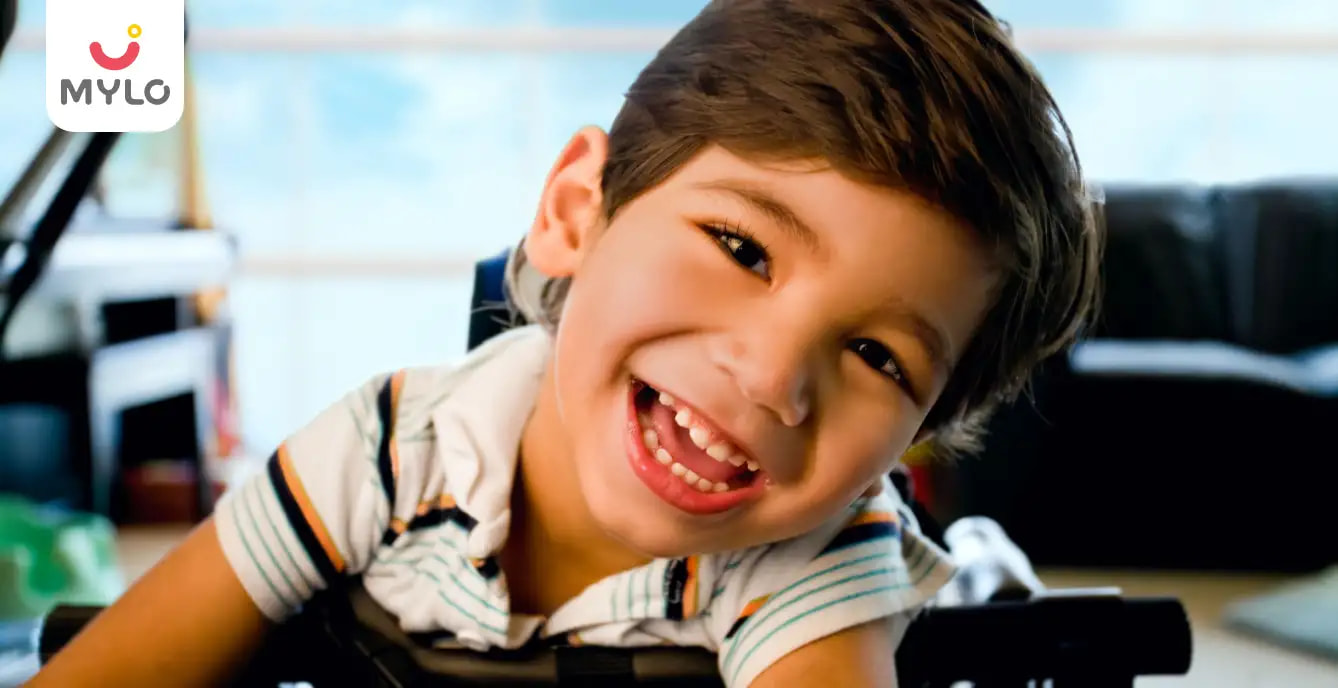Home

A Comprehensive Guide to Understanding Cerebral Palsy in Children
In this Article

A Comprehensive Guide to Understanding Cerebral Palsy in Children
Updated on 3 November 2023
Cerebral palsy is a neurological disorder that affects the movement and coordination of the muscles. It is caused by damage to the brain before, during, or after birth. It can range from mild to severe and can affect someone’s ability to do everyday activities. While there is no cure for cerebral palsy, treatments can help improve symptoms and quality of life for those living with the condition.
This article is meant to provide a comprehensive overview of cerebral palsy, its causes, symptoms, treatments, and ways to cope with the condition.
What is Cerebral Palsy?
Cerebral palsy (CP) is a neuromuscular disorder that affects movement, coordination, and posture. It is caused by damage to the brain either before, during, or after birth. It is one of the most common physical disabilities in childhood and affects 1 in 500 to 1 in 1000 live births worldwide.
CP can affect the muscles of the body in different ways. It can cause difficulty in movement, balance, and coordination. It can also cause difficulty in speaking, swallowing, and eating. Additionally, CP can cause seizures, mental disabilities, and other physical disabilities.
The severity of CP can vary greatly, and the signs and symptoms can range from mild to severe. Mild cases may cause some difficulty walking, while more severe cases may cause a person to be completely dependent on others for their daily activities.
Also Read : Childhood Disorders: Meaning, Symptoms & Treatment
Causes of Cerebral Palsy
The exact cause of CP is still unknown, but it is believed to be caused by a combination of several factors. These include premature birth, lack of oxygen before or during birth, infections or illnesses contracted before or during birth, genetic factors, and birth trauma.
1. Premature birth
Premature birth can increase the risk of CP because the brain is not fully developed at this stage.
2. Lack of oxygen
Lack of oxygen before or during birth can also increase the risk of CP because the brain needs oxygen to develop properly.
3. Infections and illnesses
Infections or illnesses contracted before or during birth can also increase the risk of CP. These include bacterial meningitis, viral encephalitis, and maternal infections.
4. Genes and family history
Genetic factors can also increase the risk of CP. Certain genetic conditions, such as Down syndrome, can increase the risk of CP. Additionally, a family history of CP can increase the risk of developing the condition.
5. Birth trauma
Finally, birth trauma can increase the risk of CP. Birth trauma can include a difficult delivery, a difficult labor, or a traumatic delivery. These can cause the baby to be deprived of oxygen or can cause damage to the brain.
Cerebral Palsy Symptoms
The symptoms of cerebral palsy can vary from person to person. Some of the most common symptoms include:
-
Difficulty with movement, balance, and coordination
-
Problems with speaking, swallowing, and eating
-
Muscle stiffness or tightness
-
Muscle spasms or uncontrollable movements
-
Mental disabilities
-
Mobility problems
-
Vision or hearing problems
It is important to note that CP affects everyone differently. Some may experience mild symptoms, while others may have to endure more severe symptoms.
Treatments for Cerebral Palsy
There is no cure for CP, but there are treatments that can help improve symptoms and quality of life. The most common treatments for CP include:
1. Physical therapy
Physical therapy can help in improving muscle strength and coordination. It can also assist in improving mobility and balance.
2. Occupational therapy
Occupational therapy can help with coordination, self-care skills, and everyday activities.
3. Speech therapy
Speech therapy can help with some of the communication and swallowing problems.
4. Medications
Medications can help control muscle spasms, seizures, and other symptoms.
5. Surgery
Surgery can be used to correct joint deformities or to release tight muscles.
Also Read : Identifying Developmental Disorders in Toddlers
Diagnosing Cerebral Palsy in Children
Cerebral palsy is generally diagnosed in infancy or early childhood. Doctors will usually look for signs and symptoms of CP, such as difficulty with movement and coordination, muscle stiffness, and seizures.
To diagnose CP, doctors will usually do a physical exam, a neurological exam, and imaging tests. The physical exam will look for signs of CP, such as abnormal movements or muscle stiffness. The neurological exam will look for signs of damage to the brain, such as vision or hearing problems. Imaging tests, such as MRI or CT scans, can show if there is any damage to the brain.
It is important to note that the diagnosis of CP can take time. Doctors may need to do multiple tests and exams in order to make an accurate diagnosis.
Coping with Cerebral Palsy
Living with CP can be difficult, but there are ways to cope with the condition. It is important to seek support from family and friends, as well as from healthcare professionals. Additionally, it is important to stay informed about the condition and to learn about available treatments and therapies.
It is also important to stay physically active. Exercise can help improve muscle strength and coordination, as well as overall health and wellbeing. It is important to talk to a healthcare professional before beginning any exercise program.
Finally, it is important to have realistic expectations. It is important to remember that CP is a non-progressive disorder, meaning it does not get worse over time. Learning to accept the condition and adapting to the changes it brings can help improve quality of life.
You may also like: Tay Sachs Disease: Causes, Symptoms, Risks & Treatment
Adaptive Equipment for Cerebral Palsy
Adaptive equipment can help people with CP better manage their condition and improve their quality of life. Some of the most common adaptive equipment for CP include:
1. Wheelchairs
Wheelchairs can help with mobility, as well as with balance and coordination.
2. Braces and splints
Braces and splints can help with posture and alignment, as well as with muscle stiffness.
3. Communication devices
Communication devices can help people with CP communicate more easily.
4. Bathroom equipment
Bathroom equipment can help people with CP with activities such as bathing and toileting.
5. Computer equipment
Computer equipment can help people with CP with activities such as typing and using the mouse.
Behavioral Therapies for Cerebral Palsy
Behavioral therapies are another way to help people with CP manage their condition and improve their quality of life. Behavioral therapies can help people with CP learn new skills, gain independence, and improve communication.
Some of the most common behavioral therapies for CP include:
1. Applied behavior analysis
Applied behavior analysis (ABA) helps people with CP learn new skills and behaviors.
2. Cognitive behavioral therapy
Cognitive behavioral therapy (CBT) helps people with CP identify and change negative behaviors and thoughts.
3. Social skills training
Social skills training helps people with CP improve communication and social skills.
4. Physical therapy
Physical therapy can help people with CP improve muscle strength and coordination.
5. Occupational therapy
Occupational therapy can help people with CP improve self-care skills and everyday activities.
Conclusion
While there is no cure for cerebral palsy, treatments can help improve symptoms and quality of life for those living with the condition. Living with CP can be challenging, but with the right support and treatment, people with CP can lead fulfilling and independent lives.
If you or someone you know has been diagnosed with CP, it is important to seek medical advice and to learn about available treatments and therapies. With the right resources and support, people with CP can lead happy and healthy lives.
References
1. Patel DR, Neelakantan M, Pandher K, Merrick J.(2020). Cerebral palsy in children: a clinical overview. Transl Pediatr.
2. Agarwal A, Verma I. (2012). Cerebral palsy in children: An overview. J Clin Orthop Trauma.



Written by
Anupama Chadha
Anupama Chadha, born and raised in Delhi is a content writer who has written extensively for industries such as HR, Healthcare, Finance, Retail and Tech.
Read MoreGet baby's diet chart, and growth tips

Related Articles
Related Questions
Hello frnds..still no pain...doctor said head fix nhi hua hai..bt vagina me pain hai aur back pain bhi... anyone having same issues??

Kon kon c chije aisi hai jo pregnancy mei gas acidity jalan karti hain... Koi btayega plz bcz mujhe aksar khane ke baad hi samagh aata hai ki is chij se gas acidity jalan ho gyi hai. Please share your knowledge

I am 13 week pregnancy. Anyone having Storione-xt tablet. It better to have morning or night ???

Hlo to be moms....i hv a query...in my 9.5 wk i feel body joint pain like in ankle, knee, wrist, shoulder, toes....pain intensity is high...i cnt sleep....what should i do pls help....cn i cosult my doc.

Influenza and boostrix injection kisiko laga hai kya 8 month pregnancy me and q lagta hai ye plz reply me

RECENTLY PUBLISHED ARTICLES
our most recent articles

Diet & Nutrition
গর্ভাবস্থায় আলুবোখরা: উপকারিতা ও ঝুঁকি | Prunes During Pregnancy: Benefits & Risks in Bengali

Diet & Nutrition
গর্ভাবস্থায় হিং | ঝুঁকি, সুবিধা এবং অন্যান্য চিকিৎসা | Hing During Pregnancy | Risks, Benefits & Other Treatments in Bengali

Women Specific Issues
স্তনের উপর সাদা দাগ: লক্ষণ, কারণ এবং চিকিৎসা | White Spots on Nipple: Causes, Symptoms, and Treatments in Bengali

Diet & Nutrition
গর্ভাবস্থায় পোহা: উপকারিতা, ধরণ এবং রেসিপি | Poha During Pregnancy: Benefits, Types & Recipes in Bengali

Diet & Nutrition
গর্ভাবস্থায় মাছ: উপকারিতা এবং ঝুঁকি | Fish In Pregnancy: Benefits and Risks in Bengali

Diet & Nutrition
গর্ভাবস্থায় রেড ওয়াইন: পার্শ্ব প্রতিক্রিয়া এবং নির্দেশিকা | Red Wine During Pregnancy: Side Effects & Guidelines in Bengali
- ইনার থাই চ্যাফিং: কারণ, উপসর্গ এবং চিকিৎসা | Inner Thigh Chafing: Causes, Symptoms & Treatment in Bengali
- গর্ভাবস্থায় ব্রাউন রাইস: উপকারিতা ও সতর্কতা | Brown Rice During Pregnancy: Benefits & Precautions in Bengali
- Velamentous Cord Insertion - Precautions, Results & Safety
- Unlock the Secret to Flawless Skin: 7 Must-Have Qualities in a Face Serum
- Unlock the Secret to Radiant Skin: How Vitamin C Serum Can Transform Your Complexion
- Gender No Bar: 10 Reasons Why Everyone Needs a Body Lotion
- Unlock the Secret to Radiant Skin How to Choose the Perfect Body Lotion for Your Skin Type
- Top 10 Reasons to Apply a Body Lotion After Every Bath
- Communication in Toddlers: Milestones & Activities
- How to Improve Vocabulary for Toddlers?
- A Comprehensive Guide to Understanding Placenta Accreta
- Vulvovaginitis in Toddlers Causes, Symptoms and Treatment
- Bitter Taste in Mouth During Pregnancy: Understanding the Causes and Remedies
- Subchorionic Hematoma: Causes, Symptoms and Treatments


AWARDS AND RECOGNITION

Mylo wins Forbes D2C Disruptor award

Mylo wins The Economic Times Promising Brands 2022
AS SEEN IN
















- Mylo Care: Effective and science-backed personal care and wellness solutions for a joyful you.
- Mylo Baby: Science-backed, gentle and effective personal care & hygiene range for your little one.
- Mylo Community: Trusted and empathetic community of 10mn+ parents and experts.
Product Categories
baby carrier | baby soap | baby wipes | stretch marks cream | baby cream | baby shampoo | baby massage oil | baby hair oil | stretch marks oil | baby body wash | baby powder | baby lotion | diaper rash cream | newborn diapers | teether | baby kajal | baby diapers | cloth diapers |








